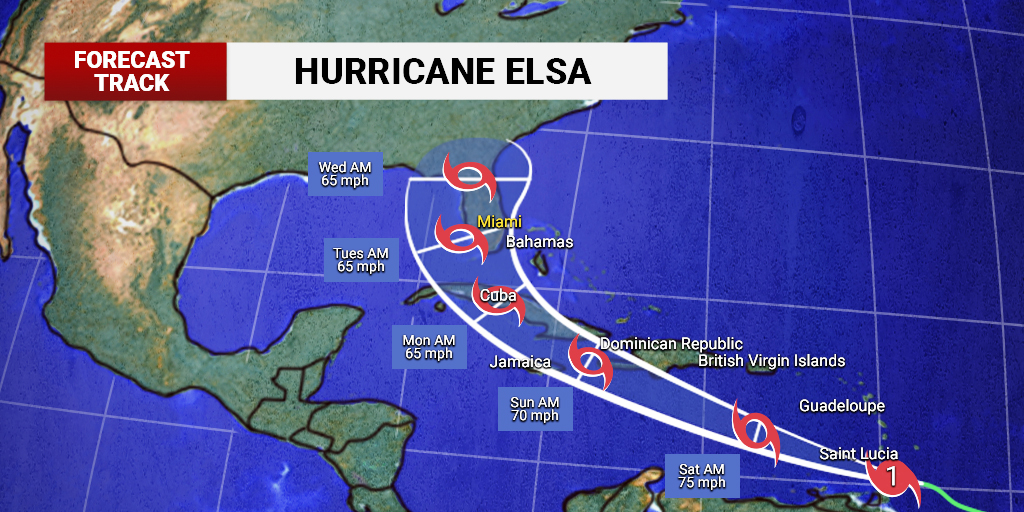
Heavy Rain, Flooding, and Chance of Severe Weather Staring Down the Southern U.S.
January 22, 2024
Posted: July 2, 2021 1:45 pm





The first hurricane of the 2021 Atlantic tropical season is here.
Hurricane Elsa is now churning in the Atlantic Ocean just to the west of Barbados in the Caribbean. This intensification came just one day after Elsa strengthened into a tropical storm. Elsa is the fifth named storm of the young 2021 hurricane season.
Although the track is not entirely certain at this point, most models show the storm approaching the US early next week. However, before it reaches the peninsula of Florida, Elsa will sweep through the islands of the Caribbean beginning this weekend.

According to the National Hurricane Center (NHC), Elsa is moving in a west-northwestward direction at a speed of 28 mph. The storm is located near Barbados and is packing maximum sustained winds of approximately 75 mph. Experts predict that Elsa will remain a hurricane as it races toward Hispaniola and Jamaica this weekend.
As a result of the rapidly strengthening storm, a hurricane warning is now in effect for Barbados, St. Vincent and the Grenadines, and St. Lucia. Barbados is already being inundated with strong wind gusts as the outer bands approach the island.
A hurricane watch is also in effect for the southern portion of Haiti. This warning area stretches from the capital city of Port Au Prince to the southern border that the country shares with the Dominican Republic.
The Windward Islands will take a beating throughout the day on Friday and into the evening hours. Wind gusts approaching 90 mph are expected across the islands of Barbados, St. Vincent, and St. Lucia. Officials are warning residents to be ready for flash flooding and power outages as Elsa makes its way across the region.
Elsa is projected to move through the eastern and central Caribbean over the weekend. Although the eye of the storm is set to pass to the south of the US and the British Virgin Islands, the southern coast of Puerto Rico may see rough surf and heavy rain and thunderstorms as the outer bands affect the area.
If the northwest track continues as expected, Elsa will likely come close to a direct strike with Hispaniola, Jamaica, and Cuba by the end of the weekend. The current trajectory is likely to deliver a significant impact to these islands. It is not out of the realm of possibility that Elsa will strengthen even further as it approaches this area of the Caribbean.
From here, Elsa’s track is not as clear. Although the storm will be moving into the warmest waters of the Caribbean, the position of the jet stream and another area of high pressure parked over the western Atlantic Ocean may work to weaken the storm as it inches closer to Florida. Elsa also may experience weakening if it tracks over the mountainous regions of Hispaniola, causing the storm to break up.
However, if Elsa churns to the south of these Caribbean islands without making a direct impact on land, the system will move into the warm waters of the Gulf of Mexico largely intact. This could mean a stronger hurricane on tap as it moves toward the US. Most models are in agreement that Elsa will eventually move into the eastern Gulf of Mexico before turning toward the Gulf Coast of Florida.
The most significant impact of Elsa on the US will not arrive until Monday evening at the earliest. The track of Elsa when she reaches the Gulf is not clear. She could make a direct hit along the Gulf Coast of Florida or could veer to the east. As such, residents along the entire southeastern coast should be monitoring the track of Elsa closely over the next several days.
Even if Florida does not take a direct hit, the outer rain bands of the storm and the associated wind gusts are going to make for a messy start to the week.
Elsa intensified into a tropical storm early Thursday morning. In the process, it became the earliest tropical storm with a name beginning with the letter “e.” Elsa originally formed off the coast of Africa before moving westward into the Atlantic Ocean and picking up steam along the way.

January 21, 2024

January 19, 2024

January 18, 2024